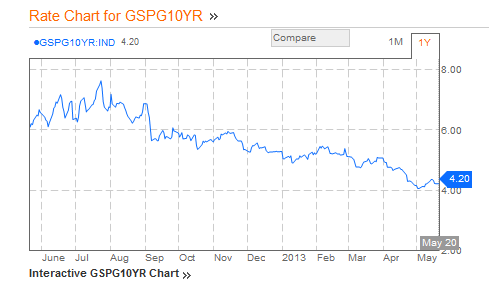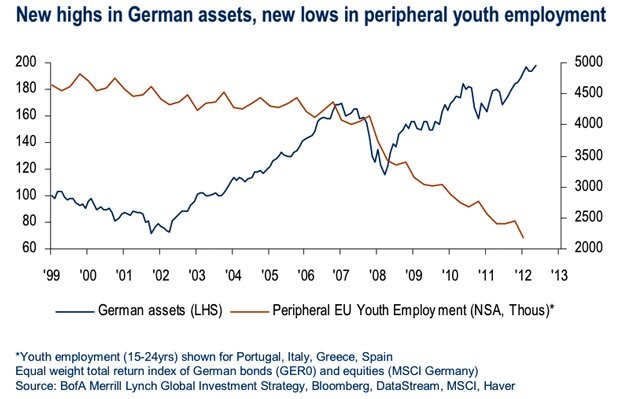Late last year I wrote that we anticipate precious metals to suffer losses in 2013. We would not be surprised if this lasts more than a year. In one of the commentaries late last year, I was also wondering if this year would be crowned as a year of vindication for central bankers. The arc-enemies of the latter are inflation (and whatever threatens price stability) and gold (since the latter defies fiat money and exemplifies fears of financial instability). In this week’s commentary, I would like to outline some of the reasons why I believe that in the foreseeable future precious metals will follow a downward trajectory, and relate that to the proclaimed “recovery” in Euroland.
Let’s start with precious metals. Here are some facts:
- The extreme monetary measures taken over the last three years have started bearing “fruits” in terms of lowering the fear premium, hence threats of disorderly disintegration are reduced substantially, and thus equities markets experience gains.
- As the fear premium declines, risk appetite rises, and therefore the safe haven that precious metals offer might be not needed after all.
- As risk appetite rises, lending increases, and thus the monetary reserves are partially (but in a limited way) converted into money supply, allowing the reversal of the money multiplier.
- As the above takes place, trade rises and with that the role of the dollar, which in turn ignites the old negative correlation with precious metals.
- The fact that there is a collateral gap between $5.7-$11.2 trillion in the balance sheets of banks (see last week’s commentary), forces the latter to look for ways to create capital in order to close that gap. This capital search reinforces lending directives in order to cover part of the funding gap. (In our humble opinion the gap cannot be bridged, and thus our call for a breakup of the large banks).
- Naked short positions by institutional players could possibly mean a balance sheet earthquake that could make them shake in abnormal ways. Therefore, vested interests may have to gain if precious metal prices decline.
- Bullion banks are reported to be facing a shortage required to satisfy customers’ demands for the bullion as well as futures’ contracts. Such shortages could have devastating effects (let’s not forget the reported failure of ABN-AMRO to deliver physical gold when asked about two months ago), and thus it is very beneficial if precious metal prices decline and sales of gold and other precious metals take place to cover those shortages.
- The collateral hole in combination with the time-bomb called derivatives creates a de facto unstable financial environment that threatens the global real economy. Ultimately, gold preserves wealth and is real money. Institutions in their search for collateral and security for a possible day of reckoning find opportunities to buy bullion at lower prices.
- The open discussions by central banks to directly buy equities and/or lend to companies in association with the decision made to bail-in depositors in the next round of bank capitalizations during a crisis, encourage the spirit of party-making, especially now that inflation has been defeated, and “stability” seems to be returning in the markets.
- What all these mean for the investment outlook for the rest of the year? Precious metals are still projected to decline, the equities party is anticipated to continue, but prudent investors buy bullion.
What then should we say about the proclaimed “success stories” from Spain, to Greece, and Portugal, and the revived confidence in the Euroland? The graphs below show the declining yields of Spanish and Greek bonds. This is indicative we are told of the “success turnaround story”, and if that is even perceived as true, we should not be surprised to see precious metals to experience lower prices.
There are reported stories of funds that desire to invest in peripheral and Southern Europe, and expectations are being elevated that now that “Grexit” is history, Greece will be welcomed back in the markets within a year with a ten-year note whose yield will be than 6%.
Very briefly we could say the following: If the hope is about more debt issuance and other paper assets, those countries did not learn the lesson of putting their houses in order. They did not learn that success is not the ability to issue debt but rather the ability to produce real things, to innovate, to create capital and wealth, to wake up dormant assets, to cut waste, to advance hard asset holdings and to enhance competitive advantages. That fascination with debt issuance is lethal. In an environment of financial instability, a bond in the balance sheet is a third party liability and that’s how it should be treated and will be treated when the music stops again.
Ratings upgrades are good. Bond rallies are nice. Rumors about hedge funds investing in local businesses are wonderful. My question is: Where is the substance? Did GDP go up? Did unemployment go down? Was a factory built? Is liquidity increasing? Is poverty and misery down? Are we serious when celebrating banks’ recapitalization when 90% of the capitalization needs is provided by government borrowing? Is the Greek Euro the same as the German Euro? (i.e. could Greek companies borrow at about the same rate as the German ones?) Are incomes higher? Are we celebrating too soon for things that do not touch the shrinking middle class? Is there any concern that we may be able to stop the hemorrhage but unable to recover the patient?
The truth of the matter is that the divergence between assets and the real economy is growing (as shown below) and as the gap increases the possibility of collapse rises too.
Why am I questioning the “progress” made? In a world that has lost its direction, its priorities, its anchors, and its heroes and which is accustomed to be amused to death via infliction of placebo pleasure treatments, I thought that it may be better instead of providing answers to question the answers provided.



